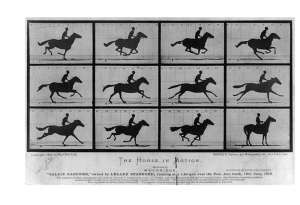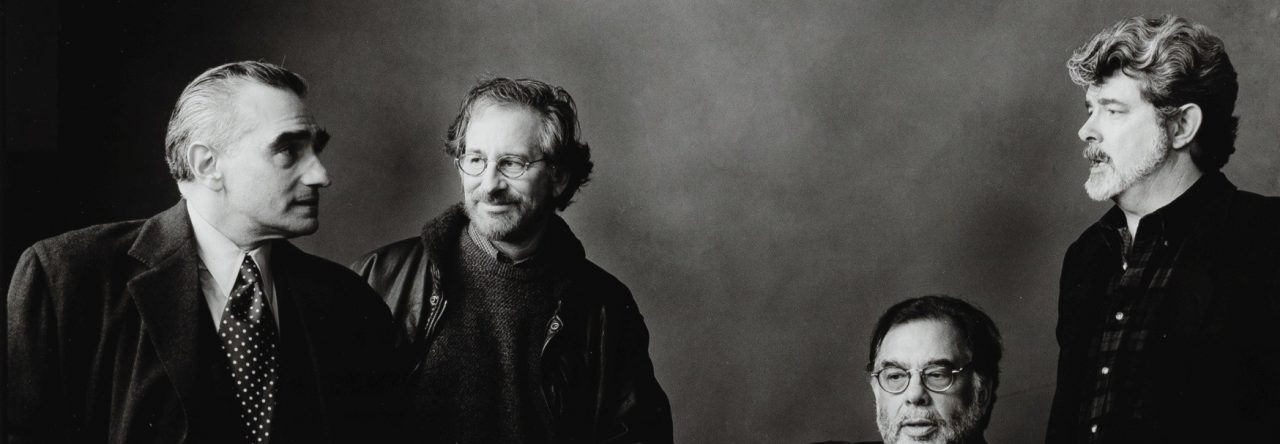When it comes to the first film, one image comes into the minds of many. The Galloping Horse or The Horse in Motion. These iconic images were one of a series of photographs shot by Eadward Muybridge. In 1872, the governor of California, Leland Stanford hired Muybridge, a famous photographer known for his photos of California, to settle a $25,000 bet about how horses stride. Stanford argued that horses stride with all four feet off the ground at full speed. [1]

Photo Courtesy from the Library of Congress. https://www.loc.gov/resource/cph.3a45870/
At first, Muybridge’s photos provided no conclusive evidence to Stanford. Since the experiment failed, Muybridge and Stanford separated. Some time passed until the next attempt.[2] During this time, Muybridge was tried for the murder of his wife’s lover and successfully plead innocent by reason of insanity.[3] Finally, in 1877, the conversation between the two started again and Muybridge went all out for his next few tests. This time, Muybridge used 12 cameras (but then 24), to snap the horse’s movement.[4] This time the tests were conclusive, and Stanford was happy. Next year, Muybridge performed the test again with Stanford and invited reporters to watch the experiment.[5] Later, Muybridge made his photos into a short movie with a device he created called the Zoogyroscope. The Zoogyroscope, which was later named the Zoopraxiscope, was an early form of a projector.[6] And with that, Muybridge made the first movie; however, his movie was not shot on film. It was just a series of photos rapidly moving. So, what was the first film?
If you do consider a series of photographs moving rapidly as a film, then Passage de Venus was the first “film.”[7] Passage de Venus was a series of photos taken by a French astronomer Pierre Janssen.[8]
However, the first actual film (that was shot on film) was Roundhay Garden Scene in 1888. This film was directed by Louis Aimé Augustin Le Prince and showed his family in the garden. It was shot on 60mm film, containing twenty frames, and lasting for only 2 seconds.
However, this film was never released to the public and was only privately screened to Le Prince’s friends and family.[9] Should we consider those films that were not shown publicly? To see what was the first publicly shown film, check out my next post.
[1] Robert Sklar, Movie-Made America: A Cultural History of American Movies (New York: Vintage Books, 1994), 6.
[2] Sklar, Movie-Made America, 6.
[3] Louis D. Giannetti and Scott Eyman, Flashback: A Brief History of Film (Boston: Allyn & Bacon, 2010), 2.
[4] Thomas D. Tucker, The Peripatetic Frame: Images of Walking in Film (Edinburgh University Press, 2019), 14.
[5] Haleema Shah, “How a 19th-Century Photographer Made the First ‘GIF’ of a Galloping Horse,” Smithsonian Magazine, last modified December 13, 2018, https://www.smithsonianmag.com/smithsonian-institution/how-19th-century-photographer-first-gif-galloping-horse-180970990/.
[6] Paul Hill and Stephen Herbert, “Eadweard Muybridge and the Kingston Museum Bequest,” Film History 10, no. 1 (1998): 100-101.
[7] “Passage De Venus (1874),” IMDb, https://www.imdb.com/title/tt3155794/.
[8] Sklar, Movie-Made America, 7.
[9] Tucker, The Peripatetic Frame, 19.
